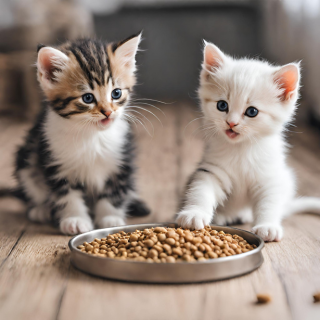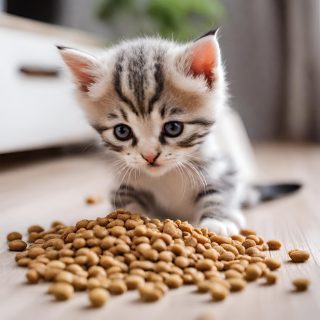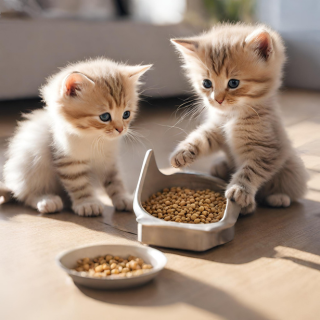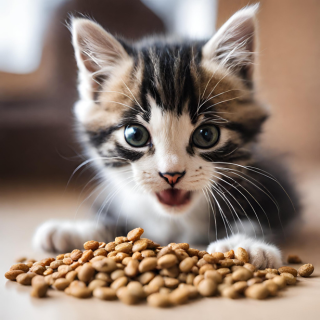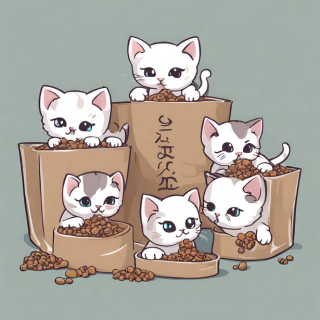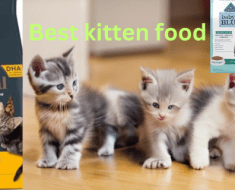Look for high-protein options with essential nutrients for the best dry kitten food for growth and development. Quality brands like Royal Canin Kitten Dry Cat Food or Blue Buffalo Wilderness Kitten Grain-Free Dry Cat Food are popular choices among pet owners.
Providing your young feline friend with a balanced diet is crucial for their overall health and well-being. When selecting dry kitten food, consider factors like ingredients, protein content, and any specific dietary requirements your kitten may have. Choosing the right nutrition will support your kitten’s growth, energy levels, and immune system as they transition into adulthood.
Remember to consult with your veterinarian for personalized recommendations tailored to your kitten’s specific needs. Selecting the best dry kitten food ultimately means investing in your furry companion’s long-term health and happiness.
What Is The Best Dry Food To Feed My Kitten?
Find the best dry kitten food that provides essential nutrients for growth and development. Choose a high-quality brand tailored to your kitten’s dietary needs for optimal health.
If you’re a new kitten owner or just looking to switch your furry friend’s diet, choosing the best dry food for your kitten is essential for their health and growth. With so many options on the market, knowing which one to pick can be overwhelming.
To help you make an informed decision, we’ve compiled a list of factors to consider when selecting the best dry food for your kitten.
Nutritional needed for kitten:
- High-Quality Protein: Look for dry kitten food that contains animal-based protein sources like chicken, turkey, or fish. Protein is crucial for your kitten’s muscle development and overall growth.
- Essential Nutrients: Ensure the dry food includes essential nutrients such as omega-3 fatty acids, DHA (docosahexaenoic acid), taurine, and vitamins. These nutrients are vital for your kitten’s brain development, vision, and overall immune health.
- Limited Fillers: Opt for dry food that has limited fillers like corn, wheat, or soy. These fillers add little nutritional value and may cause allergies or digestive issues in kittens.
Brand And Reputation:
- Choose from reputable brands known for their commitment to quality and safety. Look for brands that follow strict manufacturing standards and conduct regular testing to ensure the quality of their products.
Kitten-specific Formulas:
- Look for dry food specifically formulated for kittens. These formulas are designed to meet the specific nutritional needs of growing kittens, providing the right balance of nutrients for their development and growth.
Age And Size:
- Consider your kitten’s age and size when selecting dry food. Different formulas are available for different life stages, such as kitten, adult, or senior. Additionally, there may be variations in kibble size to accommodate the needs of different-sized kittens.
Veterinary Recommendations:
- Consult with your veterinarian to get their recommendations on the best dry food for your kitten. They can provide guidance based on your kitten’s unique needs, taking into consideration any allergies, health conditions, or dietary restrictions.
Finding the best dry food for your kitten involves careful consideration of their nutritional needs, age, size, brand reputation, and veterinary recommendations. By selecting a high-quality dry food that meets these criteria, you can ensure your kitten receives the nutrients they need for healthy growth and development.
Remember to gradually transition your kitten to the new food to avoid any digestive issues. Happy feeding!
How Do I Choose Dry Kitten Food?
Selecting the best dry kitten food involves considering your kitten’s age, breed, and specific dietary needs. Look for high-quality protein sources and essential nutrients, avoiding fillers and artificial additives. It’s important to consult with your veterinarian to ensure you choose a balanced and nutritious option for your growing kitten.
Choosing the right dry kitten food can significantly impact your furry friend’s health and well-being. Here are some key factors to consider when selecting the best dry kitten food for your precious pet:
- Nutritional Content: Ensure the dry kitten food is specifically formulated for kittens to support their growth and development. Look for high-quality protein sources, essential vitamins, and minerals.
- Ingredients Quality: Opt for dry kitten food with real meat as the primary ingredient. Avoid artificial additives, fillers, and by-products that may not provide the necessary nutrients.
- Age-appropriate Formula: Select a dry kitten food that is tailored to your kitten’s age group. Young kittens have different nutritional requirements compared to adult cats.
- Brand Reputation: Choose reputable brands known for their quality and safety standards. Read reviews and seek recommendations from veterinarians or fellow pet owners.
- Allergies and Sensitivities: Consider any existing allergies or sensitivities your kitten may have. Look for hypoallergenic options or grain-free formulas if necessary.
- Price and Budget: While cost is a factor, prioritize quality over price. Invest in a premium dry kitten food that meets your kitten’s nutritional needs for long-term health.
Choosing the best dry kitten food involves a balance of nutrition, quality, and suitability for your kitten’s individual needs. Prioritize your kitten’s health and happiness by making an informed decision based on these key factors.
What Do Vets Recommend For Kitten Food?
Vets recommend the best dry kitten food for balanced nutrition and healthy growth. High-protein formulas like “Brand X” provide essential nutrients for your kitten’s development, supporting their overall health and well-being. Choose a reputable brand to ensure the highest quality for your furry friend.
- Vets emphasize the importance of a balanced diet for kittens to support their growth and development:
- High-quality protein sources: Essential for muscle growth and overall health.
- Adequate fat content: Provides energy for playful kittens.
- Essential vitamins and minerals: Promotes bone health and immunity.
Why Do Vets Recommend These Components?
- Protein:
- Supports muscle development and tissue repair.
- Fat:
- Provides energy and aids in the absorption of fat-soluble vitamins.
- Vitamins and minerals:
- Essential for overall health, bone development, and a strong immune system.
How Can Pet Owners Ensure Their Kittens Receives These Nutrients?
- Consult with a veterinarian:
- Get personalized recommendations based on your kitten’s specific needs.
- Choose a reputable brand:
- Look for kitten food labeled as complete and balanced by the Association of American Feed Control Officials (AAFCO).
- Monitor your kitten’s growth and behavior:
- Make adjustments to their diet as needed to ensure they are thriving.
Remember, a vet’s recommendation for kitten food is crucial to ensure your furry friend receives the nutrients essential for their health and happiness. Choose wisely and prioritize your kitten’s well-being for a lifetime of purrs and playfulness!
Which Dry Food Do Cats Like Best?
Discover the top-rated dry kitten food that cats love. Specially formulated to meet their nutritional needs, these premium options provide a tasty and balanced diet for your furry friend.
Cats are known for their particular tastes, and finding a dry food that they truly enjoy can be a challenge. However, some brands have managed to create dry kitten foods that are not only nutritious but also highly palatable to our feline friends.
In this section, we will explore some of the best dry kitten food options that cats seem to prefer.
Factors That Cats Consider When Choosing Their Food:
- Flavor: Cats are known for being finicky eaters, and flavor plays a significant role in their food preferences. Brands that offer a variety of flavors, such as chicken, fish, and beef, tend to be favored by cats.
- Texture: The texture of the kibble also matters to cats. Some prefer a crunchy kibble, while others may prefer a softer texture. It is essential to consider the texture that your kitten prefers when choosing a dry food brand.
- Smell: Cats have a strong sense of smell, and the aroma of their food can greatly influence their preference. Brands that have a strong and enticing smell tend to be more appealing to cats.
- Size of kibble: The size of the kibble is another factor that cats consider when choosing their food. Some cats prefer smaller kibble pieces, while others may favor larger ones. It is essential to observe your kitten’s eating habits to determine the ideal kibble size for them.
Top Dry Food Brands Preferred By Cats:
- Brand A: Known for its wide range of flavors, Brand A offers a variety of options that cater to different tastes. Cats seem to enjoy the robust flavors and enticing aromas that Brand A provides. Additionally, the kibble size is suitable for kittens of all ages.
- Brand B: With a focus on texture, Brand B offers a range of kibbles that differ in crunchiness. Cats that are picky about texture often prefer the crunchy kibbles of Brand B. The flavors are also well-received amongst feline companions.
- Brand C: While flavor and texture are important, Brand C also pays close attention to ingredient quality. The high-quality ingredients used in their dry kitten food contribute to its palatability. They offer a variety of flavors and kibble sizes to accommodate different preferences.
- Brand D: Known for its variety of flavors and small kibble size, Brand D is a favorite among many cats. The brand also emphasizes using natural and wholesome ingredients, which further enhances its appeal.
Remember that every cat is unique, and their preferences may vary. It is crucial to observe your kitten’s reaction to different dry food brands and find the one that they enjoy the most. By considering factors like flavor, texture, smell, and kibble size, you can find the best dry food that your furry friend will love.
Is Dry Food Better For Kittens?
Discover the benefits of feeding your kitten with quality dry food. It provides essential nutrients for growth, dental health, and convenience. High-quality dry kitten food is a popular choice among pet owners for its balanced nutrition and affordability.
Dry kitten food has been a popular choice among cat owners for its convenience and longer shelf life. Let’s delve into the reasons why dry food is considered beneficial for kittens.
Nutritional Benefits Of Dry Kitten Food:
- Essential Nutrients: Dry kitten food contains all the essential nutrients required for a kitten’s growth and development.
- Dental Health: The crunchy texture of dry food helps in reducing tartar buildup and promotes better dental health for kittens.
- Convenient Feeding: Dry food is easy to store, measure, and feed, making it a convenient option for busy pet owners.
Potential Drawbacks Of Dry Kitten Food:
- Hydration: Kittens may not consume enough water when eating dry food, leading to potential dehydration.
- Preservatives: Some dry kitten foods may contain preservatives and additives that are not ideal for a kitten’s overall health.
While dry kitten food offers nutritional benefits and convenience, it’s essential to consider the potential drawbacks and ensure that kittens have access to sufficient water. As a responsible pet owner, it’s important to evaluate the specific needs of your kitten and consult with a veterinarian to make an informed decision about their diet.
What Age Can Kittens Eat Dry?
Kittens can usually start eating dry food around 8 weeks, as it helps develop their teeth and jaws. Opt for high-quality dry kitten food specifically formulated for their nutritional needs to support their growth and overall health.
Kittens typically start eating solid food around four weeks of age. Nevertheless, their teeth and digestive systems are still developing, so it’s crucial to introduce dry kitten food at the appropriate time. Here’s what you need to know about when kittens can begin eating dry food.
- Four to Eight Weeks: During this period, kittens should mainly consume mother’s milk or a milk replacer designed specifically for kittens. It’s inadvisable to introduce dry kitten food at this stage since their teeth are not yet strong enough to handle it.
- Eight Weeks and Older: At this stage, kittens can start transitioning to dry food. Begin by moistening the dry food with water or kitten milk to make it easier for them to chew and digest. Gradually reduce the amount of liquid as the kittens become more accustomed to the texture and taste of dry food.
- Kittens with Health Concerns: If a kitten has specific health issues or has been weaned prematurely, consult a veterinarian before introducing dry food to ensure it is appropriate for their condition.
Understanding the appropriate age for kittens to begin consuming dry food is essential for their growth and development. By providing the right nutrition at the right time, you can help your kitten thrive as they transition to a diet of solid foods.
Do Kittens Prefer Wet Or Dry Food?
Kittens have individual preferences, but the best dry kitten food options provide the necessary nutrients for their growth and development. Choosing high-quality dry food that meets their nutritional needs is crucial for a healthy start in life.
When it comes to feeding your little furball, one question that often arises is whether kittens prefer wet or dry food. While every kitten is different and may have their preferences, it’s essential to consider the pros and cons of each option.
To help you make an informed decision, let’s explore the differences between wet and dry kitten food.
Wet Kitten Food:
- Higher moisture content: Wet kitten food contains a higher water content, which can contribute to your kitten’s overall hydration.
- Enhanced aroma and flavor: The stronger smell and taste of wet food may be more appealing to kittens, making it easier for them to transition from their mother’s milk.
- Easier to chew: The soft and moist texture of wet food is especially suitable for kittens who are still developing their teeth and gums.
Dry Kitten Food:
- Convenience and cost-effectiveness: Dry kitten food is easy to store, has a longer shelf life, and is generally more affordable than wet food options.
- Dental health promotion: The crunchy texture of dry kitten food can aid in keeping your kitten’s teeth clean by reducing plaque and tartar buildup.
- Calorie control: With dry food, it’s easier to measure portions and ensure that your kitten is getting the right amount of calories for their age and size.
Choosing between wet and dry kitten food ultimately depends on your kitten’s individual needs and preferences. Some kittens may prefer the enticing aroma and texture of wet food, while others may find dry food more enjoyable to chew. A combination of both wet and dry food can provide a balanced diet for your growing feline friend.
Considering your kitten’s age, health, and specific dietary requirements will help you make the best choice for their well-being.
Remember to consult with your veterinarian to determine the most appropriate type of kitten food based on your furry friend’s unique needs. With a balanced diet and plenty of love and care, your kitten will thrive and grow into a healthy adult cat.
Frequently Asked Questions Of Best Dry Kitten Food
What Is The Best Dry Kitten Food For Their Growth?
The best dry kitten food for growth should contain high-quality protein, essential nutrients, and no artificial additives. Look for brands that offer balanced formulas specifically designed for kittens.
How Much Dry Kitten Food Should I Feed My Kitten Daily?
You should follow your veterinarian’s recommendations based on your kitten’s age, weight, and activity level. Generally, kittens require several small meals a day, and the packaging of the food usually provides feeding guidelines.
Can I Mix Dry Kitten Food With Wet Food For A Balanced Diet?
Yes, you can mix dry kitten food with wet food to provide variety and ensure a balanced diet. However, it’s important to adjust the total daily caloric intake to prevent overfeeding and to meet your kitten’s specific nutritional needs.
What Should I Look For In The Ingredients Of Dry Kitten Food?
When choosing dry kitten food, look for high-quality protein sources, essential nutrients such as omega-3 fatty acids, and minimal fillers or artificial additives. Avoid ingredients like corn, wheat, and soy, which provide little nutritional value for kittens.
Conclusion
Selecting the best dry kitten food is essential for the health and well-being of your furry friend. By considering factors such as age, nutritional requirements, and ingredient quality, you can provide a balanced diet that supports growth and development. Remember to consult with your veterinarian for personalized recommendations.
With the right choice, you can ensure a bright and nourishing future for your adorable little feline companion.
